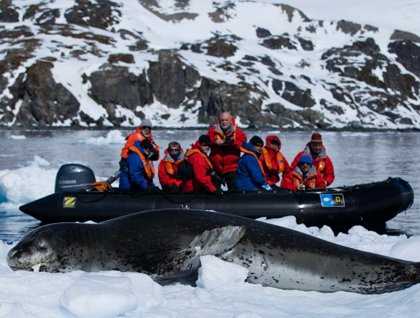This morning’s wake-up call came early, with a large gathering of approximately 40 type A Antarctic killer whales scattered across the pack ice of Gerlache Strait. John Durban and Holly Fernbach, the onboard killer whale biologists, were presented with their first good opportunity to deploy tracking instruments since our journey began. As National Geographic Explorer stood by, excited guests were given a small glimpse into Antarctic killer whale research as they watched the team deploy two tags capable of tracking location and collected two blubber biopsy samples for genetics. It was a very successful day for the research team and a very rewarding experience for all those who had the privilege to witness the event.
In calm seas and sunny weather the ship continued on its course along the west coast of Graham Land, Antarctica to Cierva Cove and the Argentine base Primavera. Cierva Cove was dominated by the massive tidewater glaciers that were pouring off the mountains into the ocean and icebergs that were the result of the calving of these glaciers. The massive ice forms towered above us, glowing green and blue in the sunlight. Basking on the pack ice in between these massive giants we found Weddell seals sunning themselves and our first close-up sighting of a basking leopard seal! This large reptilian pinniped was stretched out in the sun on a small floe, paying no mind to the surrounding Zodiacs. The prowess of this predator was plainly evident by the sinewy build and incredibly large jaws. It was a very humbling moment to be in the presence of one of Antarctica’s top predators.
As the Zodiacs glided back to the ship we were greeted with warm hot chocolate to finish off another amazing afternoon. Explorer navigated slowly out of Cierva Cove in the presence of elephant seals and humpback whales. To cap off a wonderful day, we had a small group of Antarctic minke whales porpoising off our stern. Antarctica, you never cease to amaze…







